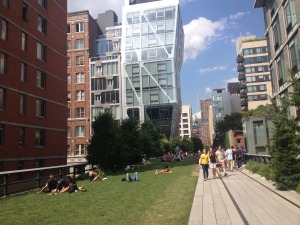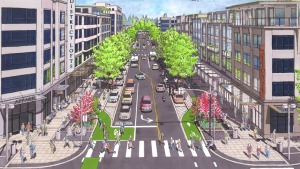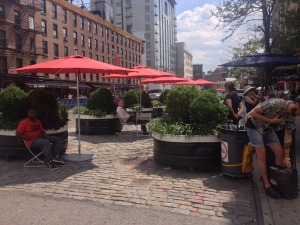 America’s car-dominated city streets are being reclaimed by pedestrians and alternative modes of transport as we re-envision the most vital part of our public commons. Since the middle of the 20th century, Americans have primarily viewed streets as transportation thoroughfares for cars to get us to our destinations. However, the recent Complete Streets approach is reshaping these public thoroughfares into destinations themselves. This new thinking in urban planning and design aims to make streets places of civic definition and social and commercial interaction, making the pedestrian living experience more of a priority.
America’s car-dominated city streets are being reclaimed by pedestrians and alternative modes of transport as we re-envision the most vital part of our public commons. Since the middle of the 20th century, Americans have primarily viewed streets as transportation thoroughfares for cars to get us to our destinations. However, the recent Complete Streets approach is reshaping these public thoroughfares into destinations themselves. This new thinking in urban planning and design aims to make streets places of civic definition and social and commercial interaction, making the pedestrian living experience more of a priority.
Complete Streets
As people rediscover the modes of walking and cycling as efficient and enjoyable ways to get to places, communities are envisioning streets to begin accommodating all users, including vehicles, transit, bicycles, and most importantly, pedestrians. Integrating transportation and land use planning with community needs helps create a more successful public space, with the local amenities, street facilities and transportation options complementing each other and establishing a sense of place.
 This also means not only looking at the street pavement aspect for motorized vehicles, but also the sidewalk, “street furniture,” trees, and the buildings and surrounding uses that line the street. Creating a complete street is as much about aesthetic design as it is functionality, since place-making requires elements of sociability, comfort and image, activities, accessibility and linkages to other places. Safety and visual perception are also big factors that affect a typical street’s sense of place, and key reasons why unclean streets with few businesses and fast traffic are unappealing and feel unsafe. Therefore, streets must be designed for appropriate speeds using traffic calming mechanisms such as intersection design, building setbacks and speed limits to have more people-friendly motorist speeds. Combined with these basic principles, these qualities contribute to more successful streets[i]:
This also means not only looking at the street pavement aspect for motorized vehicles, but also the sidewalk, “street furniture,” trees, and the buildings and surrounding uses that line the street. Creating a complete street is as much about aesthetic design as it is functionality, since place-making requires elements of sociability, comfort and image, activities, accessibility and linkages to other places. Safety and visual perception are also big factors that affect a typical street’s sense of place, and key reasons why unclean streets with few businesses and fast traffic are unappealing and feel unsafe. Therefore, streets must be designed for appropriate speeds using traffic calming mechanisms such as intersection design, building setbacks and speed limits to have more people-friendly motorist speeds. Combined with these basic principles, these qualities contribute to more successful streets[i]:
- Attractions and destinations
- Identity and image
- Active edge uses
- Clustered amenities
- Management
- Seasonal strategies
- Diverse user groups
- Accommodates traffic, transit and pedestrians
- Blending of uses and modes
- Neighborhood preservation.
Taking back the commons
 Place-making in streets takes many different forms, from community efforts envisioning traditional public spaces to people-friendly destinations. Alleyways typically carry the perception of being downtrodden and forgotten places that are dirty and unsafe. However, many cities and communities are revitalizing their alleys, creatively transforming them into people-friendly places filled with public art and small businesses. By bringing in businesses and programming to these alleys, communities create an amenity and destination that improves the public quality of life.
Place-making in streets takes many different forms, from community efforts envisioning traditional public spaces to people-friendly destinations. Alleyways typically carry the perception of being downtrodden and forgotten places that are dirty and unsafe. However, many cities and communities are revitalizing their alleys, creatively transforming them into people-friendly places filled with public art and small businesses. By bringing in businesses and programming to these alleys, communities create an amenity and destination that improves the public quality of life.
Even residential streets are beginning to see more family-oriented activity on them, with more communities hosting temporary events such as block parties and closing their streets to traffic for children to enjoy the play space. This extended public space encourages communities to interact and create a greater neighborhood identity.
Urban streets, the stereotype for car congestion, are also being transformed with the proliferation of parklets and sidewalk extensions occupying parking spots that provide added amenities such as restaurant seating, bike parking, or landscaping. This unconventional transformation demonstrates an easy way to create a more pedestrian-friendly street and public place.
With Americans increasingly wanting more walkable communities and access to amenities, our streets provide great opportunities to create good quality public places that define our daily living. From dense urban centers to smaller residential suburbs, we can transform our streets to become more lively centers of human activity, engendering a culture that lives out in the public sphere once again.
[1] Streets as Places: How Transportation can Create a Sense of Community. http://www.pps.org/reference/streets-as-places-how-transportation-can-create-a-sense-of-community/

